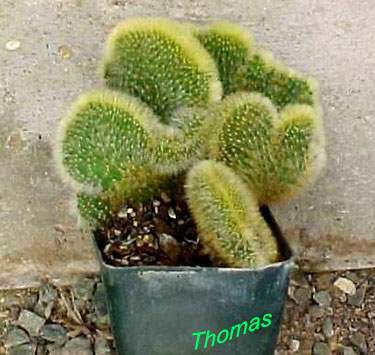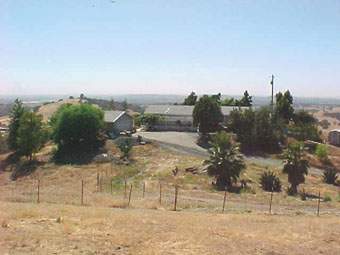Keith and Lorraine Thomas,
California, USA
The begining of this material is here
 |
| Photo 13. |
Photo 13. The two Gymnocalycium together were one of my show plants. The light one on the left was about 13 inches tall and finally died. I believe it was because of not enough chlorophyl to maintain it. The other more round one is a Gymnocalycium saglionis. I still have it and it is basketball size. It flowers every year for me. I tried to grow some seed, but they came out as normal coloring.
 |
| Photo 14. |
Photo 14. Mammillaria sp. 1 that yellowish green has hardly any chlorophyl and doesn't grow very fast. It has not flowered yet.
 |
| Photo 15. |
Photo 15. The Mammillaria sp. 2 is still one that I am not sure of. The green growth is tending to take over and I don't see any more yellow.
 |
| Photo 16. |
Photo 16. Mammillaria sp. 5 will be interesting to keep an eye on. I wonder which will take over, the green growth or the variegation.
 |
| Photo 17. |
Photo 17. Echinocactus sp. variegated is one of the very best. I love the difference in the coloring and the clean look of it.
 |
| Photo 18. |
Photo 18. The Myrtillocactus geometricans crests are usually cut up every year and new ones are rooted.
 |
| Photo 19. |
Photo 19. There is one Myrtillocactus that is all green and I have not found out what species it is.
 |
| Photo 20. |
Photo 20. Pilocereus variegated form. This is a slow growing plant and I have taken off several cuts during the 10 years I have had it.
 |
| Photo 21. |
Photo 21. Cleistocactus baumii crest.
 |
| Photo 22. |
Photo 22. Borzicactus aurispina crest. These are commonly grafted on a Hylocereus undatus. I usually take them off and root them. They will make really nice looking specimens.
 |
| Photo 23. |
 |
| Photo 24. |
 |
| Photo 25. |
Photo. 23 – 25. Keith and Lorraine Thomas live here.





